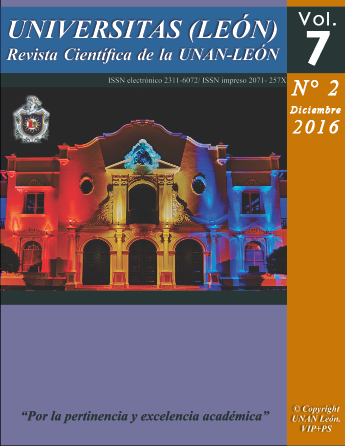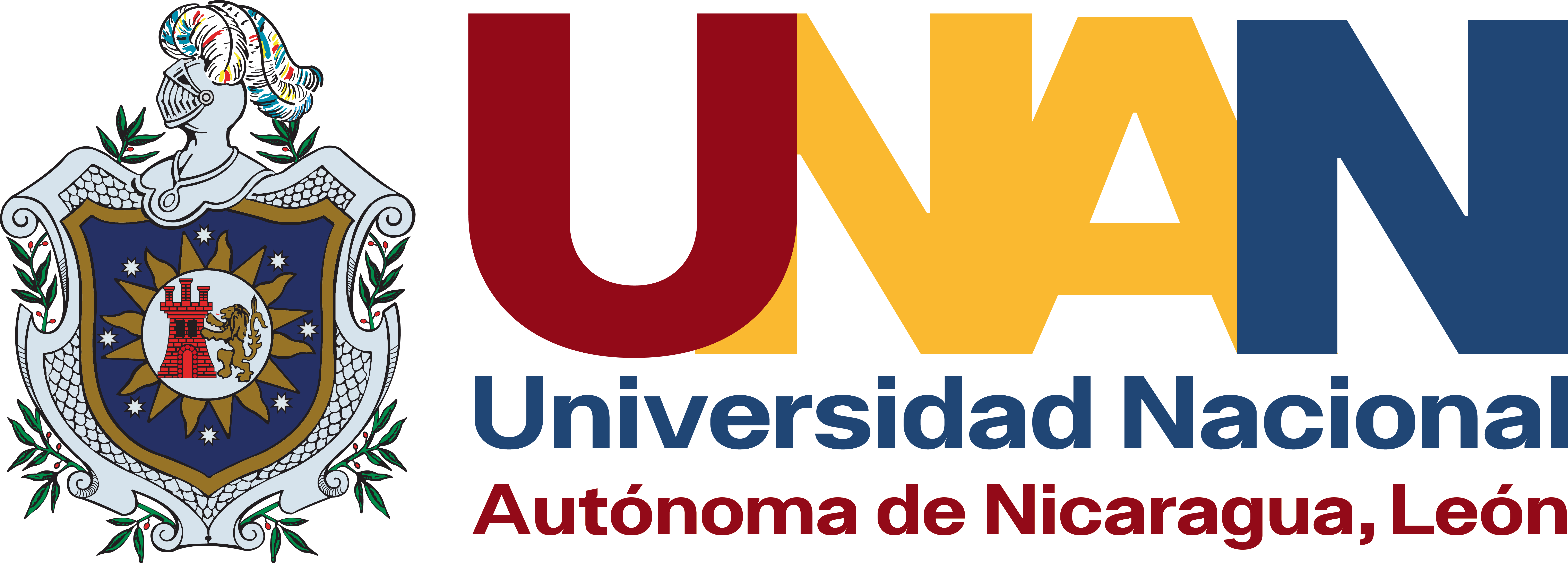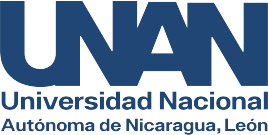Evaluación de la implementación de aula virtual en dos componentes currriculares electivos de la Facultad de Odontología, UNAN-León II semestre 2015
DOI:
https://doi.org/10.5377/universitas.v7i2.13869Palabras clave:
Aulas virtuales, Modalidad virtual, Aprendizaje en línea, Aprendizaje semi-presencialResumen
El presente artículo tiene la finalidad de evaluar la implementación de aula virtual en dos componentes curriculares de Facultad de Odontología, UNAN-León desde la perspectiva de estudiantes y docentes, se realizó un estudio con metodología mixta, tomando como población a 55 estudiantes y 2 docentes de la carrera de Odontología; la parte cuantitativa tipo descriptivo se recolectó mediante una encuesta predefinida tipo Colles; la parte cualitativa se desarrolló con entrevista grupal a los estudiantes y entrevistas individuales a los docentes colaboradores con análisis interpretativo reduccionista. Encontrándose que, en general, la implementación de la modalidad virtual en la carrera de Odontología, fue evaluada como positiva tanto por docentes como por los estudiantes entrevistados. Los estudiantes valoraron muy favorablemente el logro de elementos de las competencias: la relevancia de los componentes, el pensamiento reflexivo y la interpretación, destacando un excelente apoyo del tutor dentro de las ventajas percibidas destacan el uso flexible del tiempo, la facilitación de los aprendizajes, así como la disponibilidad de los recursos didácticos, sin embargo, expresaron como desventaja la falta de familiaridad con la tecnología y falta de interacción entre los participantes.
Descargas
Citas
Cabero-Almenara, J., & Marín-Díaz, V. (2014). Posibilidades educativas de las redes sociales y el trabajo en grupo. Percepciones de los alumnos universitarios. Comunicar: Revista Científica de Comunicación y Educación, 21(42), 165-172. https://doi.org/10.3916/C42-2014-16
Castañeda Quintero, L. J., & Adell, J. (2010). Los Entornos Personales de Aprendizaje (PLEs): una nueva manera de entender el aprendizaje.
Cordero Torres, J. A., & Caballero Oliver, A. (2015). La plataforma Moodle: Una herramienta útil para la formación en soporte vital. Análisis de las encuestas de satisfacción a los alumnos e instructores de los cursos de soporte vital avanzado del programa ESVAP de la semFYC. Atención Primaria, 47(6), 376-384. https://doi.org/10.1016/j.aprim.2015.02.006
Donolo, D., Chiecher, A., & Rinaudo, M. C. (2004). Estudiantes en entornos tradicionales ya distancia. Perfiles motivacionales y percepciones del contexto. Revista de Educación a Distancia (10).
Hinojo, M., & Fernández, A. (2012). El aprendizaje semipresencial o virtual: una nueva metodología de aprendizaje en Latinoamericana de Ciencias Sociales, Niñez y Juventud, 159-167.
López, M., Cano, D., Celma, M., Quero, A., & Rodríguez, A. (2011). Docencia Universitaria Semipresencial. Experiencia del uso de la plataforma virtual SWAD. Educación Médica 1-6.
Maldonado Berea, G. A., & Vega Gea, E. M. (2015). Actitud de los estudiantes universitarios ante la plataforma moodle. Pixel-Bit: Revista de medios y educación (47), 105-117. https://doi.org/10.12795/pixelbit.2015.i47.07
Martínez, C., & Fernández, M. (2013). La práctica educativa 29_300.
Pérez Cervantes, L., & Saker Barros, A. (2013). Efectividad del uso de la plataforma virtual en el proceso de enseñanza y aprendizaje en la universidad de Magadalena. Revista de Tecnología ¦ Journal Technology, 68-78.
Sánchez-Santamaría, J., Sánchez-Antolín, P., & Ramos, F. J. (2012). Usos Pedagógicos De Moodle En La Docencia Universitaria Desde La Perspectiva De Los Estudiantes (Educational Uses of Moodle in University Teaching from the Student's Perspective). Revista iberoameciana de educación, 60, 15-38. https://doi.org/10.35362/rie600441
Scagnoli, N. I. (2005). Estrategias para motivar el aprendizaje colaborativo en cursos a distancia.
Vidrio Talavera, P. D., Gómez Zermeño, M. G., & Zambrano Izquierdo, D. (2015). Valoración didáctica del uso de Moodle en la educación media superior. Revista Apertura, 7(1).
Villar, G. (2008). La evaluación de un curso virtual. Propuesta de un modelo: Recuperado de:< http://www. oei. es/tic/villar. pdf.
Descargas
Publicado
Cómo citar
Número
Sección
Licencia
Derechos de autor 2016 Universidad Nacional Autonòma de Nicaragua, Leòn

Esta obra está bajo una licencia internacional Creative Commons Atribución-NoComercial-CompartirIgual 4.0.
Copyright © 2025 Universitas (León), Revista Cientifíca de la UNAN-León. Uiversidad Nacional Autónoma de Nicaragua, León. Dirección Académica. Departamento de Investigación. Unidad de Publicaciones y Eventos Científicos.










